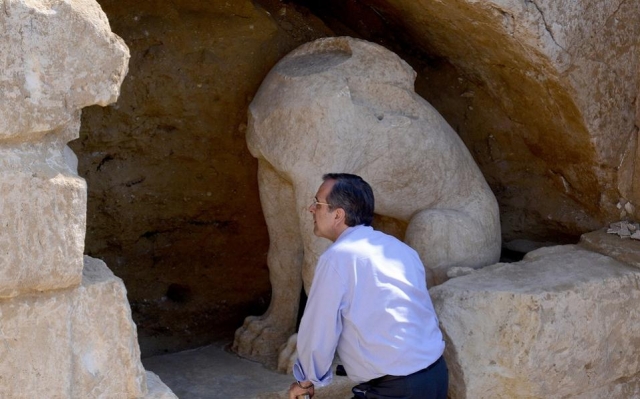Archaeologists are a step away from revealing the secrets of the Kasta tumulus near Amphipolis that have been hidden for centuries. According to well-informed sources from the Greek Ministry of Culture and Sports, referred to by "Kathimerini" newspaper, probably two walls divide the scientists from the main part of the tomb entrance. They have found two guarding sphinxes on both sides, placed opposite each other, on which there are traces of paint. Each of the statues, however, weighs 1.5 tons and this is hampering the work of the archaeologists who must proceed with caution to avoid the risk of demolition.
About 10-15 steps lead to a corridor that, in turn, leads inside the tomb. For this purpose, however, a considerable amount of soil must be removed. The persons in charge of the excavations believe that the second wall is at a distance of about 6-7 metres. According to them the works will require help from the engineers of the archaeological service in Serres, who will have to work for at least 15-20 days, their first task being to remove the soil from the entrance.

The impressive size of the tomb with a length of almost 500 metres lined with about 2,500 cubic metres of Thassos marble, as shown by estimates, a height of 30 metres and perfect round shape impresses the visitor. The sphinxes at the entrance and the huge corridor with a width of 4.5 metres that leads inside the tomb bring to the fore the opinion that this is was an expensive structure, even at the time of its construction.
The surprise visit of Greek Prime Minister Antonis Samaras to Amphipolis has provoked a strong interest, giving rise to different and bold assumptions that are reinforced by the fact that a police squad is guarding the tomb.
In turn, archaeologists stress that their famous colleague Manolis Andronikos, the discoverer of the three Macedonian royal tombs in Vergina, was preparing for a month before entering the tomb in order not to cause problems in the stability of the monument. According to them, the same should happen now in Amphipolis, despite the fact that their colleagues are so close to the interior of the tomb.

Of course, the big question is who lay or is lying in it, especially after the discoveries have sparked the imagination of many Greeks. According to different "judgments", this could be even the grave of Alexander the Great, although the most "popular" theory is that, most probably, it belongs to his wife Roxana and their son Alexander IV of Macedonia.
Leading archaeologists, however, reject this possibility because of the fact that she and her son were killed by order of Cassander, a general and the most important successor to Alexander the Great, who became the king of Macedonia. According to them, it is unlikely for such a tomb to have been built for them.
The majority of the Greek archaeologists believe that a prominent admiral or general of the army of Alexander the Great was laid in the tomb. As Samaras’ enigmatic words "Be patient for a few more days" suggest, revealing the identity of the buried person(s) is only a matter of time.